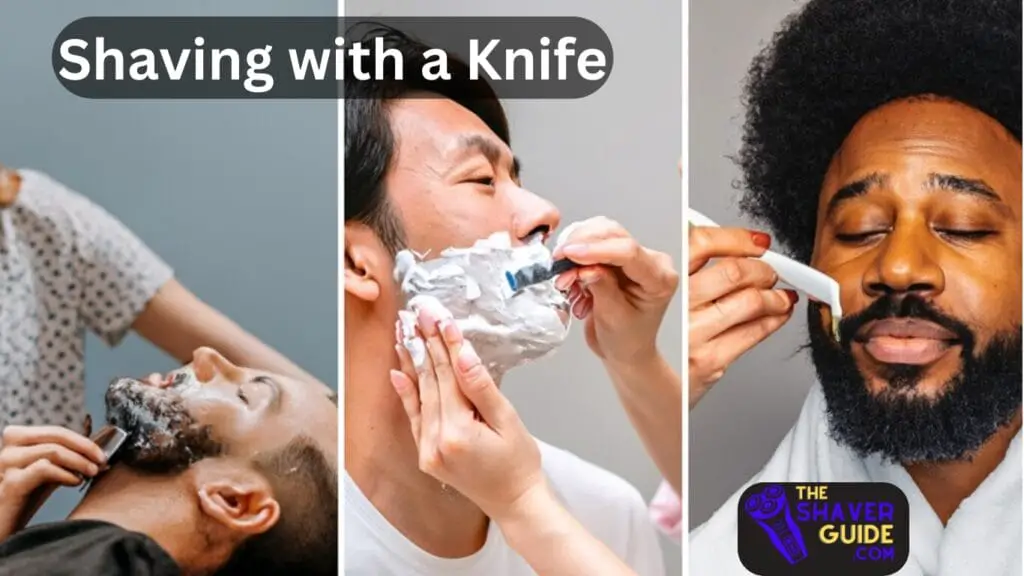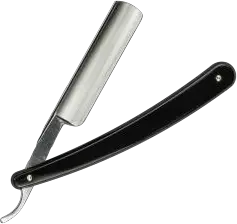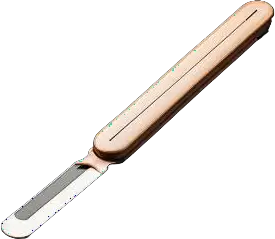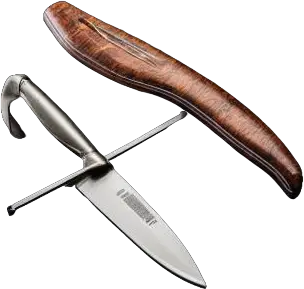
In an age of high-tech razors with vibrating handles, pivoting heads, and 5 blades, shaving with an old-fashioned knife may seem outdated or insane. But many wet shaving enthusiasts argue that using a knife, such as a straight razor or shavette, provides an unparalleled shave that modern cartridge razors can’t replicate.
Shaving with a knife has a long history but has declined in popularity over the past century. Still, it retains devotees who swear by the experience and unique results.
We will dive into the most commonly asked questions about knife shaving to help you decide if it’s right for you:
· Is it Okay to Shave with a Knife?
· Can a Knife Get as Sharp as a Razor?
· Can You Shave with a Pocket Knife?
· What is the Name of a Shaving Knife?
· What Are the Pros and Cons of Shaving with a Knife?
· What Kind of Knife Do You Use to Shave?
· How to Shave with a Straight Razor or Shavette
· Maintaining and Caring for a Shaving Knife
· Beginner Mistakes to Avoid
· The Verdict: Should Modern Men Embrace Knife Shaving?
By the end, you’ll know whether shaving with a blade is a dying art to relegate to history or a hidden gem worth unearthing for the modern man.
Table of Contents
Is It Okay to Shave with a Knife?
The first question many people have about knife shaving is – can you shave with a knife safely? Or will you end up hurting yourself?
The short answer is yes, you can shave with certain knives safely and effectively. Knife shaving has a long tradition and was the primary method of shaving before the introduction of the safety razor.
Straight razors, shavettes, and other purpose-built shaving knives are designed specifically for shaving. When used correctly on clean, hydrated skin, they can deliver incredibly smooth, clean shaves.
That said, shaving with a knife has some inherent risks. The blades are extremely sharp and require caution. Cuts and nicks are common when learning. You also have to maintain proper technique to avoid irritation or ingrown hairs.
It’s advisable to invest in a quality knife specifically made for shaving rather than trying to shave with a random pocket or kitchen knife. Learn proper handling and care. And take the time to practice good technique.
With the right knife, preparation, and method, shaving with a blade is perfectly safe and effective for most men. It just has a steeper learning curve than a cartridge or electric razor.
Can a Knife Get as Sharp as a Razor?
For those wondering if a knife can ever get as sharp as a razor, the answer is a resounding yes. In fact, knives designed specifically for shaving are often sharper than disposable cartridge razors.
Straight razors and shavettes use exposed double-edged blades made of very hard, fine-grained steel. This allows for an incredibly sharp edge. Well-made straight razors are professionally honed on leather strops and hones to achieve sharpness down to an angle of 15 degrees or less.
In comparison, your average drugstore cartridge razor has an edge angled at 30-40 degrees. This makes the blade relatively thick and blunt in comparison to a knife at a 15-degree angle. The multiple blades and lubricating strips on cartridges also reduce true sharpness.
A properly sharpened straight razor or shavette can effortlessly slice a hair hanging in the air in half. This demonstrates how incredibly keen the edge can get, sharper than most commercial razors.
Of course, that sharpness comes with responsibility. You must carefully maintain that razor edge and handle it with care to avoid injury. But if you’re willing to learn the required skills, a knife for shaving can achieve remarkable, unparalleled sharpness exceeding most razors.
Can You Shave with a Pocket Knife?
Pocket knives are an ideal shaving tool – razor sharp and easily portable for travel. However, shaving experts caution against using the average pocket or folding knife to shave.
Pocket knives have blades designed for utility purposes like slicing, peeling, or stripping. They typically aren’t shaped in a way conducive for facial shaving. The blades also aren’t beveled for the extreme sharpness needed to cut hair without tugging and irritation.
Attempting to shave with a random pocketknife can result in a mediocre shave at best and serious cuts or skin damage at worst. The uncontrolled blades can cause accidental slips and slices on the intricate contours of the face.
However, it is possible to sharpen certain pocketknives specifically for shaving purposes. Short, flat blades around 3 inches long work best. You’ll need to grind and hone the edge to a fine point of 15 degrees or less. Stropping on leather and refreshing the edge regularly is ideal.
For those determined to use a pocketknife for shaving, specialized modifications, and careful honing can make it feasible. But you’re still better off using a purpose-built straight razor or foldable shavette for the safest, closest shave.
What is the Name of a Shaving Knife?
There are a few different types of traditional knives designed explicitly for shaving facial hair:
Straight Razor:

A straight razor has a fixed blade and a traditional exposed edge. The classic “cut-throat” razor, straight razors must be properly stropped and honed to maintain sharpness. Expert technique is required.
Shavette:

A shavette uses a removable double-edged razor blade in a folding body. It allows for blade changes. The temper of the slim blades provides close shaves.
Kamisori:

A Japanese-style straight razor with a handle-less blade. Kamisoris are smaller than European straight razors and require precise control.
Ustura:

A Middle Eastern knife featuring a short, curved blade perfect for detailing beards and mustaches. The edge is extremely fine.
Barber’s Knife:

A broad term for various knives used by barbers for shaving patrons. It can include straight razors, shavettes, or specialized utility blades. There are also some common alternative names for straight razors, including cut-throat razors, open razors, and hollow ground razors.
So, look for terms like a straight razor, shavette, kami sori, or culture if you want a knife designed specifically for shaving facial hair and optimized for detail work.
What Are the Pros and Cons of Shaving with a Knife?
Now that you understand the various options for shaving knives, what are the potential upsides and downsides of ditching the cartridge razor for a blade?
Here are some of the key pros of shaving with a knife:
· Extremely close shave and precision trimming ability: Knife blades cut incredibly close to the skin when used properly. The exposed sharp edge allows for detailed trimming around beards, mustaches, and sideburns.
· Long-lasting cost savings from razor re-use: Quality straight razors can literally last several lifetimes with ongoing maintenance. Far cheaper long term than constantly buying disposable blades.
· Reduced skin irritation when mastered: The single blade minimizes drag, pulling, and irritation versus multi-blade cartridges. Prevents ingrown hairs.
· Unique ritualistic, meditative aspect: The classic shaving ritual induces relaxation and provides mindful “me time.” Therapeutic mental health benefits.
· Classic masculine skill and sense of heritage: Learning traditional wet shaving taps into timeless skills passed down through generations.
· Durable, eco-friendly, natural materials: Shaving knives made of metal and wood biodegrade naturally, unlike plastic razors. Better for the environment.
However, there are some notable cons as well:
· Steep learning curve and risk of cuts: Shaving with an exposed blade has risks, especially during the long learning phase. Nicks and cuts can happen if you rush or use bad technique.
· Substantial initial cost for quality knife: A good straight razor or shavette costs $100+ initially. A much pricier investment than a pack of disposable blades.
· Required sharpening and stropping maintenance: Keen edges require frequent honing and stropping to maintain. Labor intensive compared to just tossing a dull cartridge.
· Not as convenient for traveling and on-the-go: Straight razors can’t go in
carry-ons. Shavettes work better for traveling but still need blade changes.
· Time investment needed to master technique: Perfect form and skill take weeks or months of practice. Frustrating at first when used to simpler shaving tools.
· Not recommended for sensitive skin: The exposed blade and potential nicks may aggravate sensitive skin. Extra precautions are needed.
The smoothness and precision of a knife shave provide the ultimate grooming experience for many wet shaving devotees. But it requires patience and diligence to perfect.
Evaluate whether your skin sensitivity, schedule, budget, and passion allow for embracing the artistic process of blade shaving. It can provide unparalleled results but with some additional maintenance and risks.
What Kind of Knife Do You Use to Shave?
If you want to get started shaving with a knife, you have several excellent options to choose from. Here are some of the best knives and brands for facial shaving:
Straight Razors:
Here are some common facts about the straight razor:
· Dovo – German craftsmanship making razors since 1906. Excellent for beginners.
· Thiers-Issard – French company specializing in forged and hand-hammered blades.
· Wadenbrun – Vintage Sheffield steel razors with traditional English styling.
· Hart Steel – Custom forged straight razors made in the USA. Higher-end option.
Shavette:
Here are some common facts about the Shavette razor:
Parker – Affordable intro shavettes with snap-together handles. Great entry point.
· Feather – Japanese-style lightweight folding holder for Feather razor blades.
· Utopia Care – Elegant chrome-plated handle with great grip and included blades.
· Vikings Blade – Interchangeable blade holder engineered for comfort and control.
For straight razors or shavette, look for full stainless steel construction and blades made in Germany, France, the UK, Japan, or the USA for optimal quality. Avoid the cheapest options and go for trusted shaving brands. With the right blade, you’re on your way to masterful knife shaving.
How to Shave with a Straight Razor or Shavette?
Ready to get started shaving with your sharp new knife? Here is a step-by-step guide to the proper straight razor and shavette shaving technique:
1. Shower or apply a hot washcloth to hydrate the whiskers and soften the skin.
2. Work up a rich lather from a quality shave soap, cream, or oil. Apply over the entire beard area.
3. Grip the razor handle near the blade end between the thumb and forefingers. Keep 3 fingers on the handle.
4. Stretch skin taut with the opposite hand. Start at the cheeks using light, short strokes with the grain.
5. Maintain a consistent angle of around 30 degrees between the blade and skin. Adapt pressure for sensitivity.
6. Rinse the blade frequently under hot water to avoid clogging. Clear stubble remnants with an across-the-grain pass.
7. Carefully shave the upper lip by pulling the skin flat and using gentle downward strokes.
8. Pull the neck skintight and shave carefully downward. Repeat any stubborn spots as needed.
9. Rinse face with cold water and apply aftershave balm. Use alum block or styptic pencil for any nicks.
10. Carefully dry the knife, wipe down, and strop around 20 times after shaving. Store safely.
Take your time learning the contours of your face. Over several practice sessions, you’ll perfect the techniques needed for flawless knife shaving.
Maintaining and Caring for a Shaving Knife
Like any fine cutting tool, a knife for shaving requires careful maintenance to keep the edge optimally sharp and prevent corrosion:
· Strop the blade on the leather 20-40 times before and after each shave. This realigns the microscopic edge rather than wearing it down.
· Thoroughly dry knives after use to avoid rust. Store safely away from moisture. Apply protective oil or grease.
· Hone periodically on a whetstone or diamond stone to remove any rolled-over steel and reform the edge angle.
· Disinfect knives occasionally by gently wiping blades with rubbing alcohol. Avoid harsh cleaning chemicals.
· Lubricate folding knives with mineral oil and ensure tight pivot screws.
· Have straight razors professionally honed and sharpened annually. Or learn to use a hone and strop yourself.
· Change shavette blades after 4-6 careful shaves. Dispose of old blades in sharps containers.
With attentive upkeep and handling, a quality shaving knife should last decades and provide thousands of velvety smooth shaves. Treat your blade with care, and it will reward you with years of service.
Beginner Mistakes to Avoid
When first starting with knife shaving, it’s easy to make some beginner blunders.
Here are common mistakes to be aware of:
· Using too much pressure – Let the weight of the blade do the work. Excessive force irritates.
· Taking on too much beard area at once – Stick to cheeks and neck first before tricky areas.
· Rushing the process – Take your time and don’t rush! Rushing leads to
accidents.
· Insufficient lather – The rich, slippery lather is essential for protecting skin and glide.
· Reusing disposable blades – Toss dull blades after max 5-6 uses to prevent tugging.
· Skipping proper stropping – Strop thoroughly before and after shaving to maintain the edge.
· Bad blade angle – Maintain a consistent 30-degree angle between knife and skin.
· Attempting advanced techniques too soon – Master fundamentals before tricky detail work.
· Not stretching skin taut – Always keep the skin stretched tight for a flat surface.
Patience and starting slow are key. Build skills gradually without impatience to avoid frustrating cuts and burns.
The Verdict: Should Modern Men Embrace Knife Shaving?
So, in conclusion, does wielding these traditional shaving knives deserve a place in the modern man’s grooming routine?
Despite the onset of safety and electric razors, straight razors and shavettes retain dedicated legions of users attracted to their tactile experience. Much like driving a stick shift or writing with fountain pens, the artistic ritual attracts those seeking to preserve venerable skills.
For environmentally mindful men aiming to reduce plastic waste, quality straight razors provide a durable alternative. The meditative process also contrasts starkly against our rushed modern age. Learning knife skills builds confidence and care.
However, the initial investment of money and time is substantial. Expect a messy learning curve. Skin conditions like eczema or keratosis pilaris may not react well to an exposed blade either. It’s not ideal for traveling or busy schedules.
But for those with the patience and passion to master traditional techniques, knives reward persistence with the closest shave humanly possible. That velvety, stubble-free result speaks for itself.
So, unwrap that finely forged blade, lather your mug, and see if this dying art still has some life. With care and dedication, the manly ritual of knife shaving stands ready to be reclaimed by the modern gentleman.
Conclusion:
In the realm of grooming, the age-old practice of “Shaving with a Knife” emerges as both a nostalgic art and a sustainable grooming choice for the contemporary man. Despite the prevalence of high-tech razors, the enduring appeal lies in the unparalleled closeness and precision achieved by straight razors and shatters. While the learning curve poses challenges, mastering the art provides a unique ritualistic experience and environmental benefits.
The choice between modern convenience and traditional craftsmanship hinges on patience, passion, and a willingness to invest in both time and quality tools. For those seeking a velvety, stubble-free result, the ritual of knife shaving beckons, ready to be embraced by the modern gentleman.
